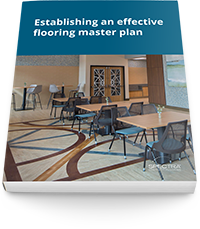Low-maintenance flooring for commercial applications: 5 materials you should consider
When selecting a flooring material for your facility, you need to take a close look at maintenance requirements, as they play a big part in the overall lifetime cost of a flooring product — sometimes exceeding the upfront material and installation costs.
That’s why it’s important to frame material selection in terms of long-term value rather than upfront cost. Or, to put it another way, you need to use value engineering principles to select your material. This means analyzing upfront costs, long-term expenses and the durability of each material to select the best-fit material for your application.
Let’s say, for example, you want to compare two material options for your commercial kitchen: Quarry tile and porcelain tile.
When comparing initial material costs, quarry tile wins by a mile. Durability’s a big concern, too, with the heavy foot traffic, potential grease spills and constant wear. Here, it’s a draw — both materials can withstand a kitchen environment. And they’re both relatively low-maintenance flooring options. For both porcelain and quarry tile, a simple sweep and mop after every shift will do. So, after comparing all factors, quarry tile would be the most cost-effective material option, both initially and in the long-term.
Long-term value should be the goal of flooring material selection. Here are five long-lasting materials which, generally speaking, come with lower maintenance costs:
1. Quarry tile
Quarry tile is about as durable as a flooring product can get, although it offers little design versatility. It’s available in earth-tones —hues of red, gray and tan— and comes in standard 6×6 or 8×8 squares.
For areas where function precedes form, though, quarry tile is a perfect fit. It’s been the industry standard for commercial kitchens for decades, and also finds a home in other back-of-house areas such as receiving areas and loading docks.
Quarry tile comes with minimum maintenance requirements, too. Quickly sweeping and mopping with a degreaser after every shift should suffice for day-to-day maintenance.
Low-maintenance and low-cost, quarry tile is a good flooring material wherever durability and wear resistance are key concerns.
2. Carpet tile
When it comes to soft-surface flooring, carpet tile is the longest-lasting and easiest to maintain. When a broadloom carpet is ruined, you have to replace an entire roll of carpet. When a carpet tile gets stained, you can simply replace that tile. It requires less labor, material and time to maintain carpet tile than it does broadloom carpet.
In many commercial applications, the added functionality and ease-of-maintenance benefits of carpet tile far outweigh its greater initial cost. And with the emergence of moisture-resistant adhesives and industrial-strength tiles, there’s almost nowhere you can’t install carpet tiles.

3. Luxury vinyl tile (LVT)
Luxury vinyl tile (LVT) is your best vinyl flooring option in terms of maintenance costs. Whereas vinyl composition tile (VCT) is much cheaper initially, it requires constant stripping, waxing and polishing to protect its surface. Because LVT is designed with an outer wear layer, it doesn’t require polish and can get by with regular sweeping and mopping.
While LVT comes with a higher price tag, it has greater design flexibility —it can be manufactured to mimic almost any material, from stone to hardwood. Low-maintenance, long-lasting and aesthetically pleasing, LVT flooring systems provide great value over their lifetime.
4. Epoxy flooring systems
Epoxy flooring systems consist of a thermosetting resin added to a concrete substrate for enhanced durability and aesthetic appeal. These systems are cheap to install, easy to maintain and last a long time. Provided the coatings are applied correctly, they’ll be chemical- and abrasion-resistant for years to come.
The maintenance regimen for epoxy flooring is simple: Sweep daily, perform a deep clean every few months and spot clean as needed. For commercial and industrial applications, epoxy systems are about as low-maintenance as it gets.
5. Polished concrete
Perfect for industrial applications, polished concrete is easy to install and cheap to maintain. To install polished concrete, we first treat the concrete substrate with a chemical densifier for increased hardness. Then we polish with a grinder and apply a sealant, which comes in many color variants to provide different looks.
Polished concrete is extremely durable, even with minimal maintenance — it’s able to withstand chemical spills, oil stains and even forklift traffic. And similar to epoxy systems, polished concrete requires only regular sweeping and spot cleaning, with occasional deep cleans. While more expensive initially than laminate or VCT, its minimal maintenance requirements result in a lower life cycle cost.
These systems —while hardly an exhaustive list of low-maintenance commercial flooring options— will provide long-term value through durability and ease of maintenance.
Choosing the right flooring material starts with choosing the right contractor. At Spectra, we’ve handled more than 400,000 flooring projects, and have learned which materials provide the best value for a wide variety of applications in terms of initial cost, ease of installation and long-term maintenance costs.
We’ve compiled everything we know into a guide aimed at helping you save money and maximize value on your flooring installation. Download our guide to saving money on commercial flooring to learn how to strategically approach material selection and sourcing with value engineering.
Or, if you’re ready to discuss the flooring needs of your facility, schedule a no-obligation consultation today.

Establishing an effective flooring master plan
Is your flooring lasting its full lifespan? These industry-proven strategies help facility managers keep flooring systems clean, safe and reliable for years to come.
